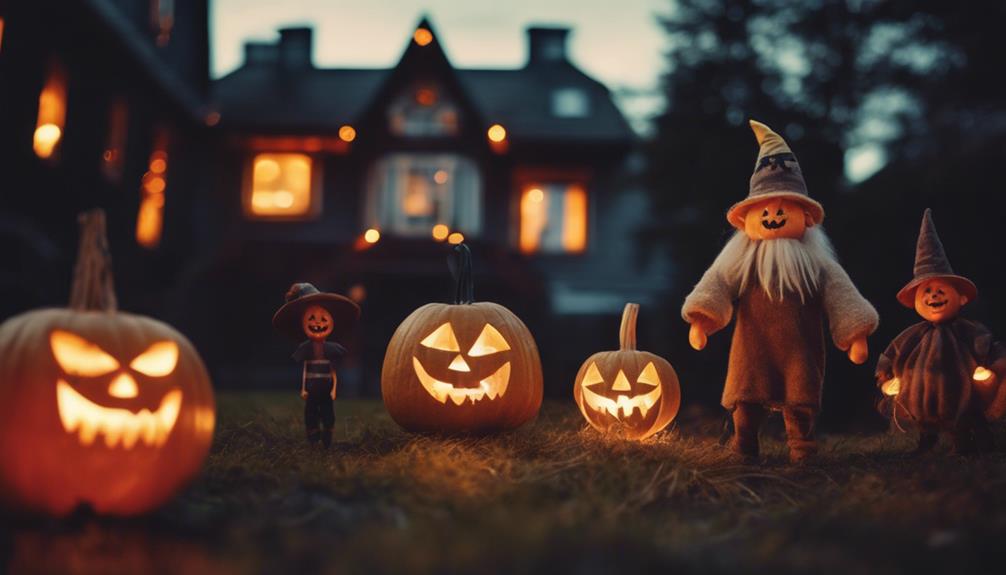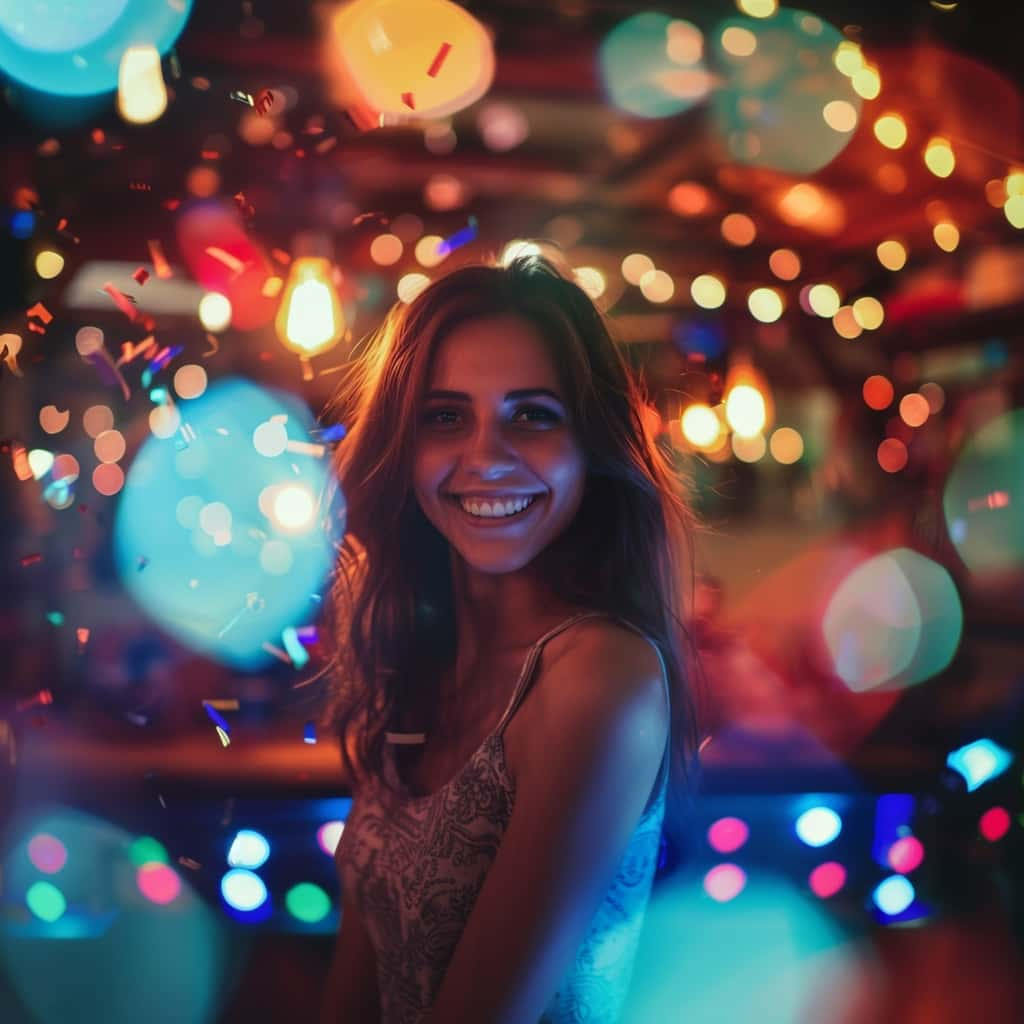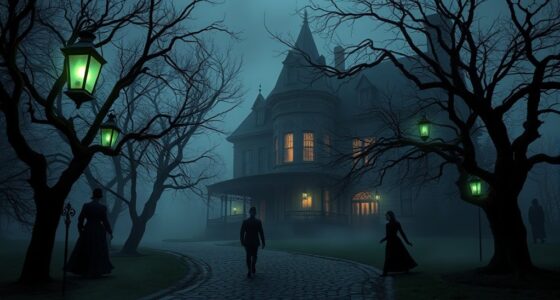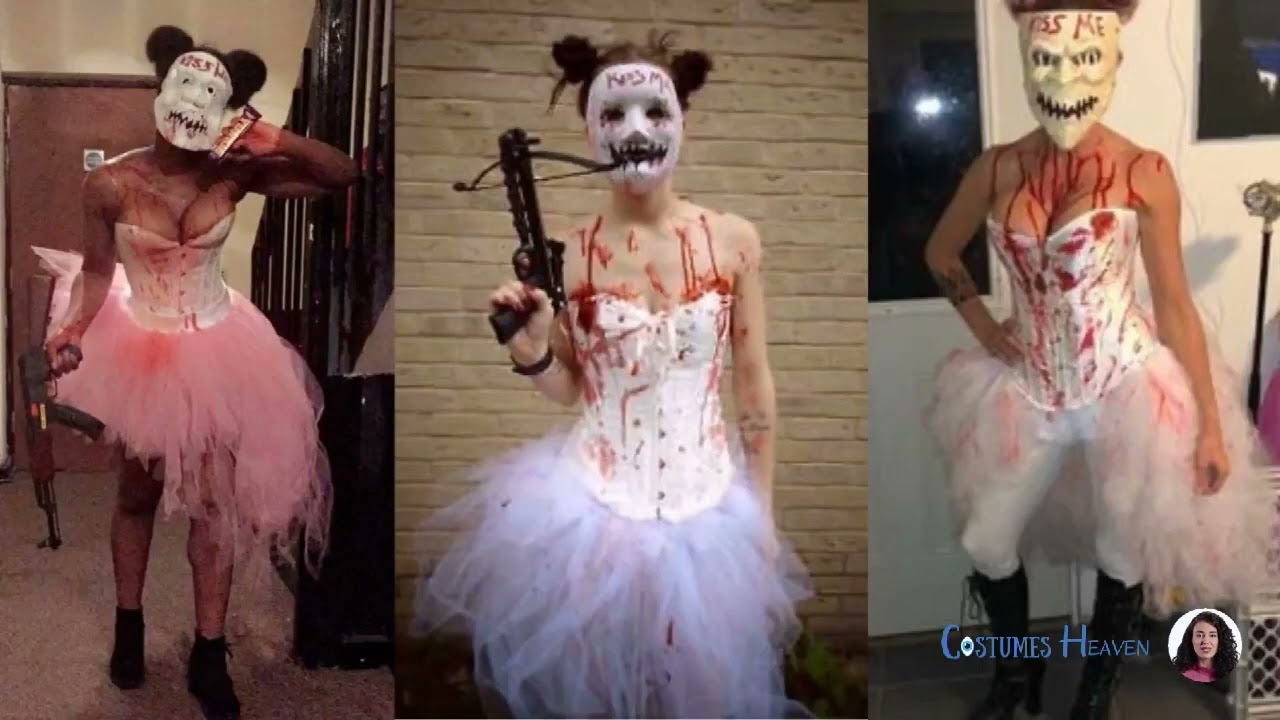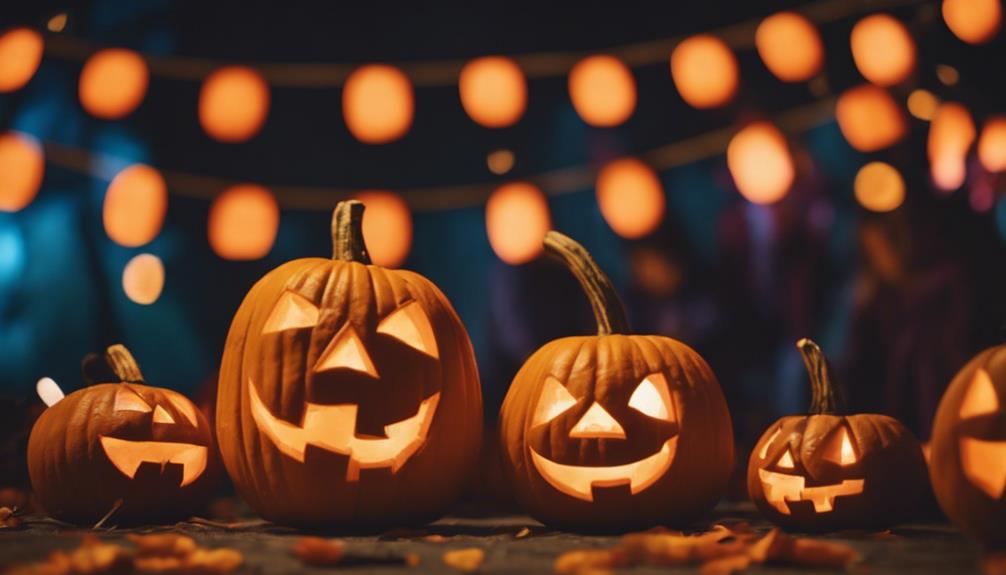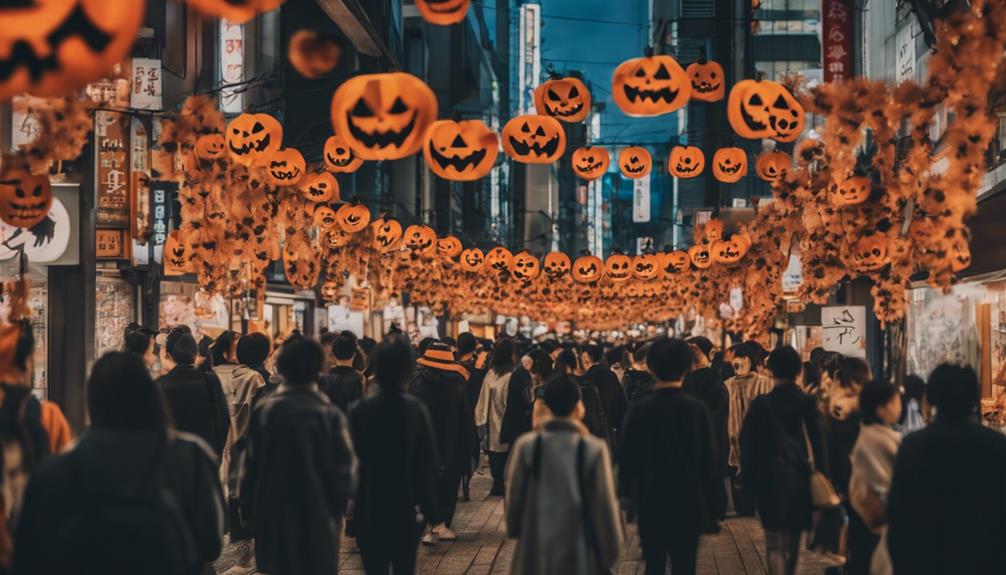Halloween's enduring appeal lies in its innovative cinematography, iconic character Michael Myers, and impact on the horror genre. The film's timeless slasher techniques and eerie atmosphere continue to captivate audiences, showcasing its lasting influence on the genre. Despite some dated elements like slang and jump scares, Halloween's palpable fear factor, with Myers lurking on Halloween night, remains a cornerstone of cinematic horror. Discover how this classic film maintains its place in the hearts of viewers through its masterful craftsmanship and unforgettable character, drawing you into the world of suspense and terror.
Key Takeaways
- Dean Cundey's cinematography and John Carpenter's music maintain Halloween's chilling atmosphere.
- Michael Myers' enigmatic character and iconic presence stand the test of time.
- The film's impact on the horror genre remains influential and timeless.
- Classic slasher techniques like knife kills and suspenseful stalking scenes still resonate.
- Dated elements exist, but Halloween's enduring fear factor and atmosphere hold up well.
Cinematography and Atmosphere
When evaluating the cinematography and atmosphere of Halloween, one can't overlook the masterful work of Dean Cundey and the enduring impact of its haunting visuals. Cundey's use of lighting and art direction in Halloween remains a benchmark in the horror genre, with his skillful play of shadows and camera angles creating a sense of unease that lingers long after the credits roll.
The iconic music, composed by John Carpenter himself, adds another layer to the film's atmosphere, setting the perfect tone for Michael Myers' chilling presence. The flickering lights, eerie sound effects, and ominous settings further enhance the suspenseful mood, drawing you into the world of Haddonfield where danger lurks around every corner.
Together, Cundey's cinematography and the atmospheric elements in Halloween work in harmony to create a timeless classic that continues to captivate audiences with its simple yet effective portrayal of terror.
Iconic Character: Michael Myers
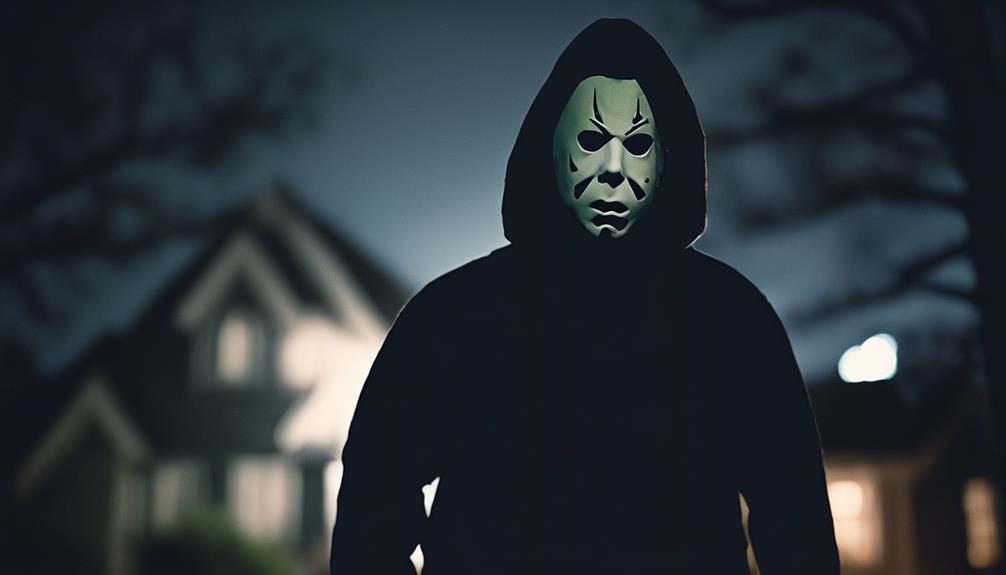
Michael Myers, the enigmatic and motiveless killer in 'Halloween,' has left an indelible mark on the horror genre. His silent stalking and chilling presence have influenced countless other villains and horror icons.
The iconic Captain Kirk mask he wears has become a symbol of fear and his legacy continues to impact the cultural landscape of horror cinema.
Michael Myers' Legacy
Considered one of the most iconic villains in cinematic history, known for his silent stalking and eerie persona, Michael Myers' legacy looms large in the horror genre. His impact as a classic horror character is undeniable, shaping the slasher genre and inspiring countless imitators.
Here are some key points about Michael Myers' enduring legacy:
- The character's mask adds to his terrifying presence, making him unforgettable to audiences.
- Michael Myers' legacy extends beyond 'Halloween,' inspiring many other cinematic killers in the horror genre.
- His portrayal as a motiveless killer and embodiment of evil contributes to his lasting impact on audiences.
- Michael Myers remains a pivotal element in the success and enduring legacy of 'Halloween' in the horror genre.
- The character's silent and relentless nature has solidified his status as an iconic villain, leaving a lasting impression on fans of the genre.
Impact on Horror
Is it Michael Myers' silent and relentless stalking that truly solidifies his status as an iconic character in the horror genre? Michael Myers, the infamous antagonist from the 'Halloween' series, has left an indelible mark on the world of horror. His eerie presence, clad in a haunting mask, strikes fear into the hearts of viewers, embodying the essence of pure evil. The character's silent demeanor and unwavering pursuit of his victims have cemented his position as a symbol of terror in cinematic history.
'Halloween' served as the launching pad for Michael Myers, propelling him into the domain of slasher film legends. The success of the original movie led to a slew of sequels and remakes, further solidifying his place in horror lore. Michael Myers' influence extends beyond the confines of the screen, inspiring other iconic killers in the genre.
With his chilling aura and relentless pursuit, Michael Myers continues to reign supreme in the domain of horror, showcasing the enduring impact of 'Halloween' on the genre.
Cultural Influence
Certainly, the influence of the iconic character from 'Halloween,' Michael Myers, permeates cultural perceptions of horror villains. Michael Myers, portrayed as the silent and relentless masked killer in the film, has left an indelible mark on the horror genre. Here are some key points that highlight his cultural influence:
- Michael Myers is known for his silent stalking and chilling presence, making him a standout figure in slasher films.
- The character's eerie mask, a modified Captain Kirk mask, enhances his terrifying persona on screen.
- Michael Myers' portrayal as a motiveless and unstoppable force of evil adds to his lasting impact on audiences worldwide.
- The character has inspired numerous other cinematic killers and horror villains, showcasing his enduring legacy in the genre.
- Michael Myers' iconic encounters with Laurie Strode, played by Jamie Lee Curtis, have become legendary moments in horror cinema, solidifying his place in the pantheon of memorable villains.
Impact on Horror Genre

'Halloween' revolutionized the horror genre by pioneering the slasher subgenre and setting a new standard for suspense and tension in films. John Carpenter's masterful direction in the original 'Halloween' greatly influenced modern horror cinema. The film's innovative approach to building fear through atmosphere and subtlety laid the groundwork for many horror movies that followed. The introduction of the iconic character Michael Myers added a new dimension to horror villains, inspiring countless filmmakers to create memorable antagonists in their own works. 'Halloween' didn't just impact one film but left a lasting legacy with numerous sequels and remakes, showcasing its enduring influence on the genre.
Carpenter's unique filmmaking style, characterized by his use of suspenseful music and skillful pacing, has become a hallmark of successful horror films. The way 'Halloween' balanced psychological terror with visceral scares has become a template for many filmmakers seeking to evoke fear in their audiences. The film's impact on the horror genre is undeniable, shaping the way we experience fear and tension in films to this day.
Timeless Slasher Techniques
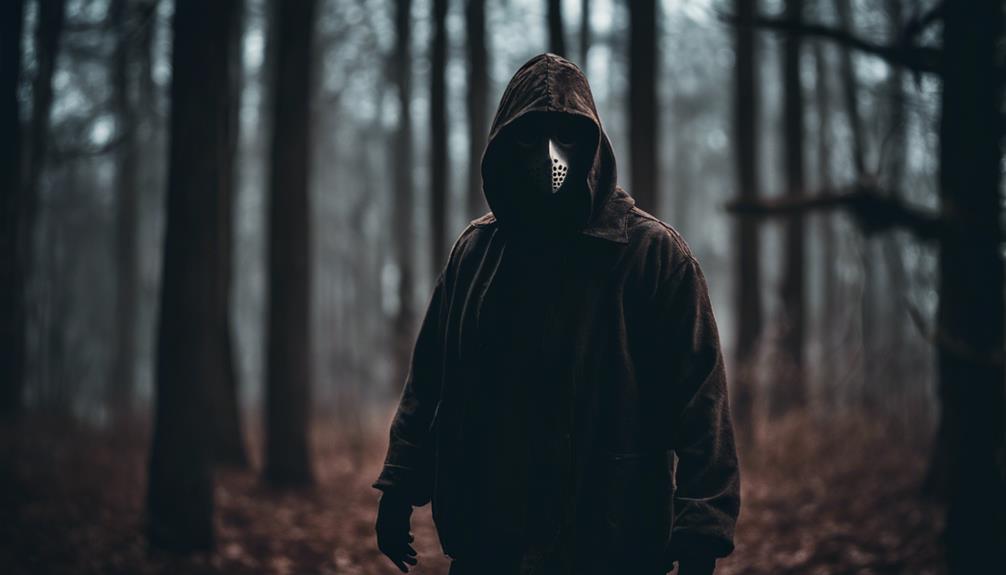
Classic slasher films like Halloween employ techniques such as suspenseful stalking scenes and iconic knife kills to keep audiences on edge. These timeless elements contribute to the lasting impact of the movie, creating an atmosphere of fear and tension that continues to resonate with viewers.
Classic Knife Kills
When exploring timeless slasher techniques, the mastery of classic knife kills in horror cinema stands out as a defining element. In the iconic movie Halloween, Michael Myers' knife kills set the standard for slasher movie techniques.
Here are some key points to ponder:
- Impact on Genre: Halloween's knife kills, executed by Michael Myers, have had a lasting impact on the horror genre.
- Iconic Status: The use of a knife as a weapon in Halloween's kills contributes substantially to the film's iconic status in horror cinema.
- Tension and Fear: Michael Myers' methodical and relentless approach to using a knife adds a palpable sense of tension and fear to the movie.
- Effectiveness of Tropes: The knife kills in Halloween showcase the simplicity and effectiveness of classic slasher movie tropes.
- Character Association: Halloween's knife kills have become synonymous with the character of Michael Myers, highlighting the film's enduring influence on horror filmmaking.
Suspenseful Stalking Scenes
Suspenseful stalking scenes in slasher films captivate audiences with their ability to build tension and fear through clever cinematography and haunting sound design. In Halloween, these scenes featuring Michael Myers silently observing his victims are truly iconic in the domain of slasher film history.
The use of point-of-view shots and eerie music cues effectively heightens the suspense, creating a chilling atmosphere that keeps viewers on the edge of their seats. The repetitive nature of the stalking sequences in the film adds to the sense of impending danger, emphasizing Michael Myers' relentless pursuit of his victims.
This relentless pursuit not only instills fear in the characters but also evokes a feeling of helplessness in the audience. The timeless slasher techniques showcased in Halloween's stalking scenes continue to resonate with viewers, solidifying the film's enduring legacy in the horror genre.
Dated Elements in Halloween

The presence of exploitative female nudity in 'Halloween' is now seen as a dated and retro aspect. Some elements in the film, like certain deaths and jump scares, might come off as less impactful and effective by today's standards.
Additionally, outdated dialogue with slang and phrases that feel out of touch with contemporary audiences contributes to the movie's feeling of being behind the times. The introduction of mythology elements in later sequels has also taken away from the original film's impact, adding to its sense of datedness.
Overall, these factors combined make 'Halloween' a product of its time, with certain aspects that may not resonate as strongly with modern viewers.
- Outdated dialogue with slang and phrases
- Exploitative female nudity
- Less impactful deaths like Bob's and Annie's
- Dated jump scares
- Introduction of distracting mythology elements in sequels
Enduring Fear Factor

Despite its dated elements, 'Halloween' continues to evoke a palpable sense of fear in modern audiences. The concept of a mysterious killer on Halloween night still strikes a chord with viewers, showcasing the enduring fear factor of John Carpenter's masterpiece. Fans of atmospheric horror appreciate Carpenter's adeptness in crafting a suspenseful mood that keeps audiences on edge throughout the film.
The scenes featuring Michael Myers' ominous presence remain as chilling as ever, instilling fear in those who watch. One can't overlook the impact of John Carpenter's iconic score, which heightens the tension and atmosphere, further solidifying 'Halloween' as one of the best horror movies of all time. Even with some aspects that may seem outdated, the overall sense of fear that 'Halloween' instills in viewers during the Halloween season is undeniable.
It continues to be a staple for those seeking a truly terrifying cinematic experience.
Frequently Asked Questions
Is Halloween Still Good?
Yes, Halloween is still considered good by many fans of the horror genre. The film's impact on pop culture and its effective use of suspense continue to captivate audiences.
Jamie Lee Curtis' portrayal of Laurie Strode as a strong final girl remains relatable. John Carpenter's direction and score are praised for their influence on the genre.
While some elements may feel dated, Halloween is still regarded as a classic and influential horror film.
Why Is There No Blood in Halloween 1978?
In 'Halloween' (1978), the absence of blood was a deliberate choice made by director John Carpenter due to budget constraints. Opting for suspense and psychological horror over gore, the minimal blood allowed the film to focus on atmosphere, character development, and a sense of impending dread.
This decision heightened the impact of the killings and emphasized the eerie nature of Michael Myers.
What Made Halloween 1978 so Scary?
Halloween (1978) instilled fear through its point-of-view shots from Michael Myers' perspective, creating an intense viewing experience. John Carpenter's minimalist storytelling and suspenseful approach built dread.
The eerie atmosphere, heightened by the iconic score, added tension. Michael Myers' silent, relentless pursuit, and emotionless mask instilled unstoppable terror.
The focus on suspense, anticipation, and the unknown amplified fear, making the lurking evil feel all too real.
Is Halloween 1978 Ok for 12 Year Olds?
Halloween (1978) isn't suitable for 12-year-olds due to its R rating for violence and terror. The film contains intense and disturbing scenes, including graphic killings, that may be too much for younger viewers.
Themes of stalking, violence, and suspense make it inappropriate for a preteen audience. Parents should consider the strong horror elements before allowing 12-year-olds to watch Halloween (1978).
It's best to choose age-appropriate movies for younger viewers.
Conclusion
To sum up, Halloween still stands as a classic horror film that continues to terrify audiences with its cinematography, iconic character, and impact on the genre.
While some elements may feel dated, the timeless slasher techniques and enduring fear factor keep viewers on the edge of their seats.
So, if you're looking for a spine-chilling experience that stands the test of time, Halloween is definitely worth a watch.

